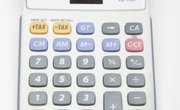Whether you're trying to get back to the pre-tax price of an item or you're calculating the amount of sales tax backwards from a receipt in your hand, the math is the same. You have to know the total amount paid, including the sales price or list price, and either the amount of tax paid or the tax rate, suggests Texas A&M University. If you have the tax rate, you can calculate the amount of tax paid; this is the total sales tax paid.
Calculating the Tax Rate
Calculating the tax rate assumes that you know the total amount you paid and the amount of tax you paid. You must figure out the sales tax percentage tax rate that was assessed. You can do this in three steps:
- Subtract the amount of tax you paid from the total, post-tax price of the item. This gives you the pre-tax price of the item. If you paid $26.75 in total for two books, and you know from looking at the receipt that $1.75 of that was tax, the books' pre-tax cost was $26.75 – $1.75 = $25.
- Divide the amount of tax you paid by the pre-tax price of the books. The result is the percentage tax rate you paid, expressed as a decimal like this $1.75 ÷ $25 = .07.
- Multiply the tax rate by 100 to convert it to a percentage. If your tax rate is .07 in decimal form, the calculation would be .07 × 100 = 7 percent. So 7 percent is the tax rate you paid on the books.
Knowing the tax paid will let you calculate the tax rate. Knowing the tax rate will let you calculate the amount of tax paid. They go hand in hand.
Calculating the Amount of Tax Paid
This method assumes that you know the total post-tax price for the item and the tax rate that was assessed. You must calculate backward to find out how much money actually went toward the sales tax.
- Add 100 percent to the sales tax rate. The 100 percent represents the whole, entire pre-tax price of the item in question. You get a total percentage that represents the pre-tax price plus the tax when you add it to the tax rate. It would be 100 + 8 = 108 percent if the sales tax in your area is 8 percent.
- Convert the total percentage to decimal form. Divide the "tax paid" rate you just calculated by 100 to convert it from a percentage into a decimal. That becomes 108 ÷ 100 = 1.08 if you had 108 percent as the tax paid rate.
- Divide the post-tax price by the decimal. Divide the post-tax, total price of your item by the "tax paid" decimal you just calculated. The result will be the pre-tax cost of the item. You'd have $42.50 ÷ 1.08 = $39.35 if you bought a stuffed animal that cost $42.50 after taxes.
- Subtract the pre-tax price from the post-tax price. Now that you know how much the stuffed animal cost before and after taxes, you can subtract the pre-tax price from the post-tax price ($42.50 – $39.35 = $3.15) to find out how much tax you actually paid. You paid $3.15.
Sales Taxes Can Vary Considerably by State
Calculating the sales tax backward isn't always easy, particularly because state sales taxes in different states can vary considerably. There’s not one easy, best-used formula, and you may not always need the information.
Some items may be taxable in one jurisdiction while others might not be taxable there. The AARP says that four states don’t charge sales tax at all, and tax laws and rules among the others can vary. Some states have both a state-level and local sales tax rate. You should have a good grasp of all of them if you have a small business and you regularly engage in online sales.
But sales tax is like income tax and the IRS: You really can’t avoid them. So calculating sales tax can be worth it, depending on your situation and why you need to know.
The Bottom Line
Simply rounding up or down rather than going through all the math can serve you under some circumstances, but you'll want to avoid that margin of error in many cases. Consider using a sales tax calculator if math isn’t your strong suit.
References
Writer Bio
This article was written by PocketSense staff. If you have any questions, please reach out to us on our contact us page.
